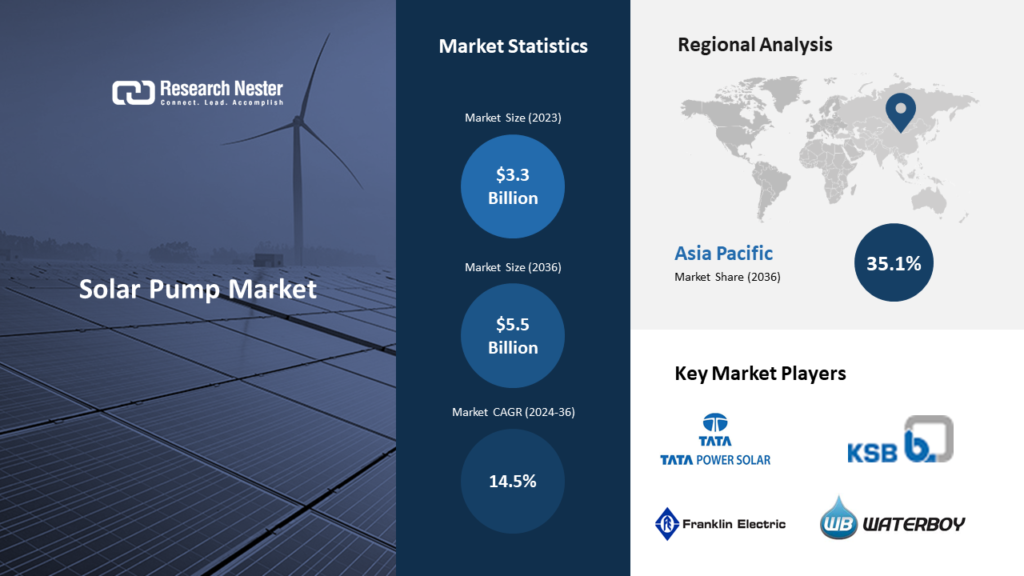Research Nester’s latest market research analysis on “Solar Pump Market: Global Demand Analysis and Opportunity Outlook 2036” provides a detailed competitive analysis and a detailed overview of the global solar pump market in terms of market segmentation by product, capacity, operation, end user, and region.
Increasing environmental awareness will increase the global market share of solar pumps
The global solar pump market is expected to grow primarily due to the growing need to reduce greenhouse gas emissions. Emissions continue to increase in many parts of the world. Therefore, reducing greenhouse gas emissions is important to slow global warming. Greenhouse gas emissions are extremely harmful to the environment. These can be reduced by using devices such as solar pumps that help reduce dependency on fossil fuels. Moreover, solar pump motors and pumps are powered by solar radiation, making them even more environmentally friendly, significantly reducing carbon dioxide emissions and helping to fight climate change. According to the International Renewable Energy Agency, global energy-related CO2 emissions need to be reduced by 70% from current levels by 2050 for the world to meet its climate goals.
Moreover, thanks to government subsidies, tax credits, and renewable energy grants, the manufacturing costs of solar photovoltaic modules have dropped significantly in recent years. This is expected to increase the demand for solar pumps in the coming years. Moreover, solar-powered surface water pumps primarily use solar energy to pump water from ponds, lakes, and rivers, making them an economical way to meet growing water demands. Moreover, solar-powered groundwater irrigation is growing rapidly, which can boost the demand for solar pumps. For instance, more than 65% of the world’s groundwater withdrawals are believed to be due to irrigation.
Some of the key growth factors and challenges associated with the growth of the global solar pump market are:
Growth Drivers:
Increasing global adoption of IoT devices
Growing Agriculture
Challenges:
Weather dependency, high acquisition cost, and lack of awareness regarding the benefits of solar pumps are some of the major factors expected to hinder the global market. Weather plays a major role as these systems require sunlight to operate. Hence, solar pump systems remain quite rare in many locations, especially those with little or no sunlight. Many farmers in rural areas continue to rely primarily on pumps powered by diesel generators due to lack of knowledge about solar pumps. This may limit the market demand.
By product, the global solar pump market is segmented into DC surface suction, AC submersible pumps, DC submersible pumps, and AC swimming pumps. The DC surface suction segment is expected to achieve the highest revenue by the end of 2036 as it will grow at a significant compound annual growth rate during the forecast period. There is an increasing demand for multiple models of high suction solar DC water pumps that pump water from shallow sources such as ponds and rivers for agricultural irrigation and pump the water to the ground surface. Moreover, AC submersible solar pumps are suitable for both domestic and agricultural use as they can pump water to greater heights and distances.
A relatively common type of submersible pump is the DC submersible pump, which is intended for use in drainage applications where there is little or no electricity.
By region, the European solar pump market is expected to achieve the highest sales by the end of 2036. This growth is expected due to the increasing need for energy efficiency. This has led to an increased demand for solar pumps in the region, as they are much more economical and energy efficient than traditional diesel pumps. For instance, in Germany, Spain, and Italy, solar photovoltaics and heat pump systems could reduce annual energy costs by around 61% to 83% by 2022.
The report also provides the current competitive scenario of the key players in the global solar pump market, including company profiles such as KSB SE & Co. KGaA, CRI Groups, Franklin Electric Co., Inc., Bernt Lorentz GmbH & Co. KG, Waterboy Pumps Pty Ltd, Shakti Pumps (India) Ltd, Grundfos, Stanley Black & Decker, Inc., Kirloskar Brothers Limited, Glynncorp Electrical, etc.
